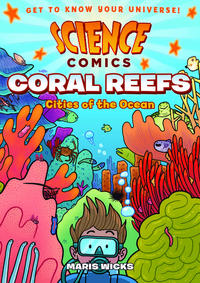(2016)
First Second,
2016 Series
Published in English
(United States)


- Price
- 9.99 USD; 10.50 CAD
- Pages
- 132
- On-sale Date
- 2016-03
- Indicia / Colophon Publisher
- First Second
- Brand
-
 Science Comics
Science Comics
- ISBN
-
978-1-62672-145-6

- Barcode
- 9781626721456 50999
- Editing
- ?
- Color
- color
- Dimensions
- 6" x 8.5"
- Binding
- trade paperback
- Publishing Format
- graphic novel
Issue Notes
Dinosaurs and Coral Reefs are the first two titles in First Second's Science Comics imprint.
[foreword]
foreword, introduction, preface, afterword / 3 pages
- Genre
- non-fiction
Indexer Notes
Text with illustrations.
Chapter One: What Is Coral?
comic story / 15 pages
- Genre
- non-fiction
- Characters
- The narrator, an unnamed yellow prawn-goby; Maris Wicks (cameo)
- Synopsis
- Coral are animals, not plants. They are invertebrates who belong to a group of animals called cnidarians. Coral live in colonies which form reefs over a period of millennia. They have a symbiotic relationship with zooxanthellae, a species of algae.
- Keywords
- biology; coral; education; educational comics; marine biology; ocean; reefs; science; sea anemones; sea jelly; self portrait; zoology
Chapter Two: How and Where Coral Reefs Are Formed
comic story / 14 pages
- Genre
- non-fiction
- Characters
- The narrator, an unnamed yellow prawn-goby
- Synopsis
- Life on earth developed about 3.8 billion years ago. It evolves and diversifies in response to local and global environmental changes. Many marine invertebrates have been around millions of years. There are three major formations of coral reefs, which can take from 10,000 to 30 million years to form: fringing reefs, barrier reefs, and atoll reefs. Most coral are Reef builders. Coral reefs occupy 0.1% of the planets surface, but are home to 25% of all animals in the ocean. They are deeply embedded in a large marine food web, and play a large role in global ocean health.
- Keywords
- biodiversity; biology; coral; ecosystem; education; educational comics; evolution; food web; marine biology; ocean; reefs; science
Chapter Three: The Coral Reef Ecosystem Explored!
comic story / 38 pages
- Genre
- non-fiction
- Characters
- The narrator, an unnamed yellow prawn-goby
- Synopsis
- Description of the system used to classify living organisms, and an overview of many species of coral and other organisms that inhabit their ecosystem, such as other cnidarians, other invertebrates, fish, sea turtles, dolphins, and humans.
- Keywords
- biology; coral; education; educational comics; marine biology; ocean; reefs; science; zoology
Chapter Four: How Are Coral Reefs Connected to the Rest of the Planet?
comic story / 15 pages
- Genre
- non-fiction
- Characters
- The narrator, an unnamed yellow prawn-goby
- Synopsis
- Water and the water cycle are integral to life on earth. Surface runoff from land, affects marine life, particularly when it contains pollution. Algae and phytoplankton produce 60-70% of the world's oxygen, therefore they are integral to life on earth. Thus the oceans are tied to many food webs. Over one billion people (1/7 of world population) are directly dependent on the ocean and marine ecosystem for survival.
- Keywords
- algae; biology; coral; ecosystem; education; educational comics; marine biology; ocean; oxygen cycle; phytoplankton; pollution; reefs; science; water cycle
Chapter Five: Little Reefs, Big Planet: Challenges, Changes, and Taking Charge
comic story / 29 pages
- Genre
- non-fiction
- Characters
- The narrator, an unnamed yellow prawn-goby
- Synopsis
- Man made climate change is having a negative effect on most of the planets ecosystems, which typically experience changes over much longer time spans. Rising oceanic temperatures cause coral bleaching. Rising temperatures cause zooxanthellae to leave the coral, causing the coral to become unhealthy. Increased carbon dioxide levels cause the ocean to absorb more carbon dioxide, which leads to ocean acidification. This is harmful to coral and other shell forming animals. Pollution also damages marine life.
- Keywords
- biology; climate change; coral; coral bleaching; education; educational comics; marine biology; ocean; ocean acidification; reefs; science
Editing
Related Scans
Table of Contents
-
0.
[no title indexed]
-
1.
[title, credits]
-
2.
[foreword]
-
3.
Chapter One: What Is Coral?
-
4.
Chapter Two: How and Where Coral Reefs Are Formed
-
5.
Chapter Three: The Coral Reef Ecosystem Explored!
-
6.
Chapter Four: How Are Coral Reefs Connected to the Rest of the Planet?
-
7.
Chapter Five: Little Reefs, Big Planet: Challenges, Changes, and Taking Charge
-
8.
Glossary
-
9.
Looking Inside: A Coral Polyp
-
10.
Bibliography
-
11.
Additional Resources
-
12.
[Acknowledgements]
-
13.
[Science Comics]
-
14.
Dive into Coral Reefs!
This issue was modified by
- Lionel English


